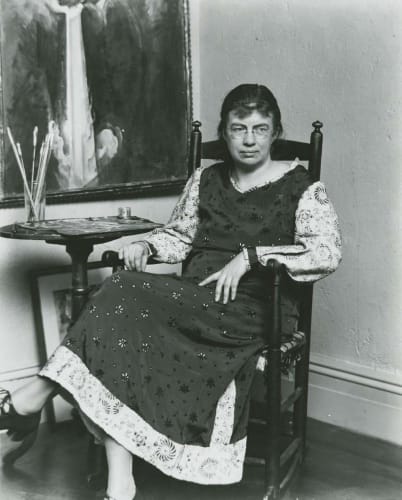Marguerite Zorach 1887-1968
My greatest ability lies in the awareness and use of relationship of form, vision and imagination... I have a sensitive appreciation and ability to handle color. I feel complete freedom to take any liberties with form and space. You may find the application of my work overpowering; it is never too much for me.
- Marguerite Zorach
For many women the liberating force of Modernism in America brought with it the possibility of escape from the confining respectability of the past and an embrace of the extraordinary freedom found in the avant-garde. Marguerite Zorach was at the forefront of this modern art movement, and along with her husband William, she was instrumental in introducing Fauvism and Post-Impressionism to America.
Raised in Fresno, California, Zorach was one of the first women admitted to Stanford University; however, only a few weeks into her studies, she was invited to join her aunt in France. Zorach had shown some artistic promise at an early age, and this trip proved to be utterly life-changing. In Paris, she immersed herself in a wealth of new artistic styles and ideas, and became increasingly drawn toward the avant-garde. She studied at La Palette, a progressive art school, and met William Zorach there. They married two years later in 1912 and moved to New York City. Their relationship was a true artistic partnership; they supported one another, exchanged ideas, and explored similar styles, techniques, and subjects, and yet they each had a distinct creative identity. In their small one-room apartment in Greenwich Village, Marguerite and William were at the heart of bohemian society, and they participated in many of the most important early exhibitions of modern art.
During their courtship, Zorach asserted emphatically that she would never fulfill society’s domestic ideal of a perfect wife. Nevertheless, when their two children were born, the primary responsibility for their care fell to her. In searching for a creative solution to this dilemma, Zorach was attracted to the vibrancy of colored wools and began making embroideries. Careful to distinguish these works from mere craft, she referred to them as “Modernistic Pictures Done in Wool” and they proved to be “very good things to do for an artist who has children to take care of.” Not only were these tapestries well-suited to her increased domestic responsibilities, they were also remarkably remunerative. Zorach financially supported her family, even through the Great Depression. She exhibited the embroideries to great critical acclaim and was credited as “the inventor of what is virtually a new art”.
